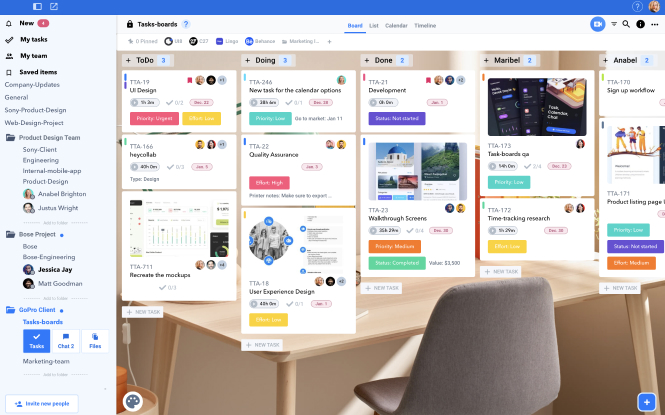Effective communication is one of the hallmarks of successful, productive, and cohesive organizations. With communication protocols, they ensure that information gets shared on time and with great accuracy. Everyone knows the objectives and everyone knows their roles. This inspires employees to unite behind a common goal.
Establishing clear and efficient communication protocols will foster collaboration, eliminate confusion, optimize workflows, and promote efficiency. In this guide to communication protocols, we explain the challenges organizations face and share ways to improve communication in the workplace.
Communication challenges in organizations
Even with increasing digitization, communication challenges have only increased in organizations. These affect productivity, collaboration, and morale. Usually, systems face the following problems in both their communication protocols:
Multiple sources
There are more sources of information now, which makes it difficult for both teams and individuals. If there are several touchpoints on the client’s side, it’s challenging to prioritize information. Similarly, if there are many managers or supervisors on a project, team members wouldn’t know who has the final authority.
Bundled information
Most project teams suffer not from too little but from too much information. Crucial details are lost because employees have to filter those from emails, chats, phone calls, meeting minutes, etc. This delays projects and leads to subpar deliverables.
Communication glut
Without viable communication protocols, teams end up creating too much communication on the same topic. If there’s any change in the timeline or project goals, the same message is conveyed through multiple channels, which clogs the system. This is how employees end up with numerous unread emails, messages, and notifications.
Asynchronous communication
Geographically dispersed teams have additional communication challenges. Certain kinds of communication may be asynchronously received, which could affect timelines. Managers might not know when an employee would be free to take a call or join a meeting. Time differences make it more difficult for distributed teams.
Cultural dissonance
Teams today comprise members from multiple domains and can even include individuals from external agencies. It’s futile to expect that they will have the same behavioral traits. Some team members may be used to more interactive communication such as meetings and phone calls. Others could be more comfortable with emails and chats.
Mismatched channels
Managers and teams without functional communication protocols end up selecting the wrong channel for communication. What should have been conveyed through chat is often communicated through needless meetings. What could have been relayed through email with the necessary documents is shared through phone calls.
Duplication of messages
When teams don’t have communication protocols and end up using channels on an ad hoc basis, there will be duplication. After a meeting, additional documents would need to be shared via email. Chats will have to be revisited through phone calls because someone may have missed the context.

6 ways to establish effective communication protocols
At an organizational level, establishing these six communication protocols will improve efficiency, collaboration, and both individual and team productivity.
1. Build a centralized knowledge hub
Organizations that have successful communication protocols have one thing in common. They have a knowledge hub accessible to team members. With such a centralized source, a lot of the communication in a project team can be avoided. Employees won’t have to disrupt their work or that of their colleagues by repeatedly asking for information.
A centralized hub can provide information about status updates and specific project details. It can also give employees access to important documents. By organizing the hub based on tasks and subtasks, managers can make it easy for team members to find relevant information. This will help in streamlining collaboration and enhancing workflow optimization.
How Heycollab can help: With Files, you get unlimited space and folders to centralize your information. Docs enable your team members to create and collaborate on documents.
2. Develop more meaningful communication
To achieve success through communication at the workplace, you need to add more meaning to communication. This begins with identifying the right format. Do you need to send an email if a phone call can get you an immediate answer? Is chat the better option when an email can have more details? Can a single meeting produce more results than emails and phone calls?
The next step is to maximize the value of each interaction. If it’s an email, keep it relevant, and add context to it. If it’s a meeting, set a schedule, develop an agenda, note down the important talking points and expected outcomes, and share them with your team. If it’s a video call, get all documents that you may have to share. Record them if you need to revisit them later.
How Heycollab can help: Use Chat for real-time, private, public, one-on-one, or group conversations. Video Calling enables teams to share their screens, record the calls, and much more.
3. Establish communication expectations
Among communication protocols, one of the most important is to set expectations. Team communication is influenced by legacy processes and culture, and by establishing clearly-defined criteria, you can bring more focus to communication. The first step is to define what kinds of channels employees can use for certain kinds of communication.
When there is clarity on what they can and cannot do, there will be little incentive for over-communication. Employees should also know who they can add to their communication and when they shouldn’t click on “reply all.” This isn’t about limiting employees from communicating. It’s about setting a guideline for more efficient and result-oriented communication.

How Heycollab can help: Heycollab’s Chat enables teams to have high-quality, integrated chat and video calling that comes with one-click file sharing. With this, employees don’t have to repeatedly ask for more details.
4. Set response rates for communication
Along with defining the format of communication, it’s important to establish appropriate response rates for each type of communication. It would be simplistic to define in terms of the time it would take. Managers shouldn’t expect their employees to constantly check their messaging platforms and answer their queries. This affects concentration and the quality of work.
You can have different response times for different formats. You can also encourage employees to take scheduled breaks to check their messages and emails. These response rates must be honored irrespective of who the sender is. Just because it’s from a senior executive shouldn’t mean that employees have to stop their work and immediately reply.
How Heycollab can help: For workflow optimization, Heycollab has Dashboards. Now you can track tasks, access workloads, and view details of assignments through context-specific interactions without the need for unnecessary communication.
5. Develop emergency protocols
At times, managers or team members would need immediate answers. If someone is unavailable, it can lead to project delays and create more work for others. The solution is to have emergency communication protocols. You should define what would be an emergency and what channel should be used on such occasions.
This isn’t merely for streamlining communication. It also encourages employees to understand how to allocate time for focused work and when to manage communication. With emergency communication protocols, employees can also afford to manage off-hours communication. If it’s an email, for example, they would know that they can handle it the next working day.
How Heycollab works: Using Projects and Tasks, you can manage projects from start to finish without the need for parallel communication.
6. Recognize that communication is work
The most important communication protocol from a manager’s point of view is to understand that communication takes effort. Chats, phone calls, video calls, and emails aren’t insignificant activities for employees. They’re also part of their schedules. And it can be exhausting managing all that communication.
Presuming that everyone will be excited to take on their tasks after a two-hour morning meeting is self-defeating. It can be tiring for employees to check their emails multiple times a day, find relevant information, and reply with details. Even phone calls can interrupt their concentration when they’re engaged in deep work.
Remember that employees will have to prepare for meetings. Similarly, they will have to analyze what was communicated during a phone call. All these emphasize the fact that communication is work. This principle should be kept in mind during employee evaluation.

Heycollab: A platform for intuitive and effective communication protocols
Heycollab brings all the tools that teams need for effective communication in one place. You get Tasks, Chat, Docs, Calls, Time Tracking, and much more for streamlining communication. You can use file sharing, instant messaging, task management, project tracking, and multi-media communication to implement your communication protocols.
What you get isn’t merely a platform that simplifies communication. Heycollab also makes it smart and intuitive by linking it to tasks, status updates, and the resources individuals need. It empowers teams to focus on their core tasks and not get sidetracked by unnecessary and trivial communication.
Sign up for Heycollab for free and see how it can help you roll out effective communication protocols.

